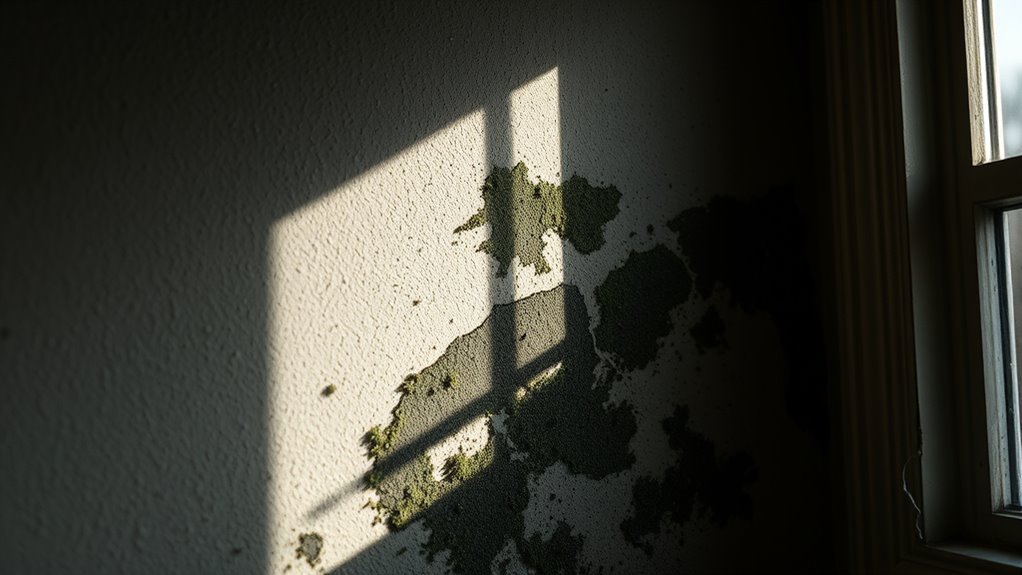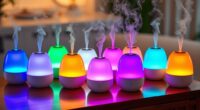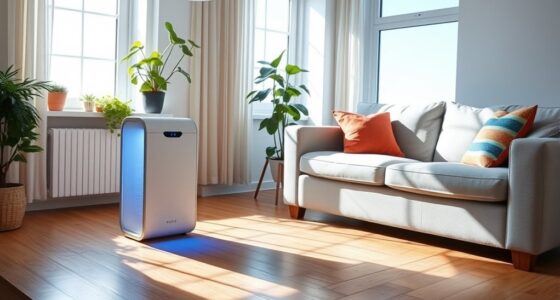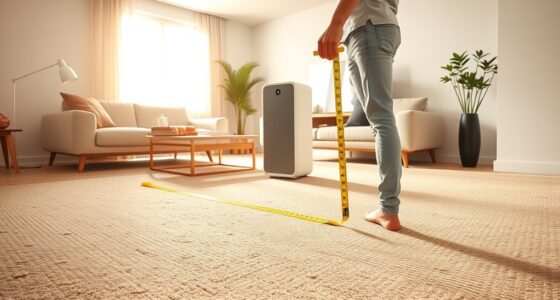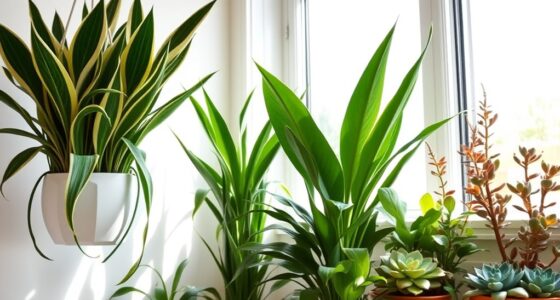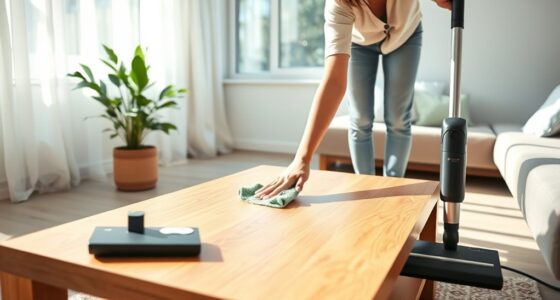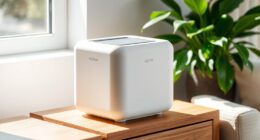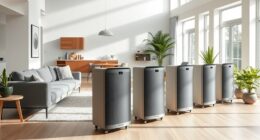Mold releases spores into the air, lowering indoor air quality and causing respiratory problems. Mold growth is often hidden behind walls or under floors, so regular inspections and moisture control are crucial. Use dehumidifiers, fix leaks promptly, and keep humidity below 60% to prevent mold from thriving. Cleaning with mold-inhibiting solutions and maintaining proper ventilation also help. To discover more ways to keep your home safe and healthy, keep exploring these effective prevention tips.
Key Takeaways
- Mold spores become airborne, decreasing indoor air quality and potentially triggering respiratory issues.
- Visible mold growth and hidden areas can harbor mold, requiring regular inspections for early detection.
- Controlling indoor humidity below 60% and fixing leaks prevent mold development and spread.
- Using HEPA filters and air purifiers captures airborne mold spores, improving air quality.
- Routine cleaning with mold-inhibiting solutions and proper ventilation reduce mold proliferation indoors.
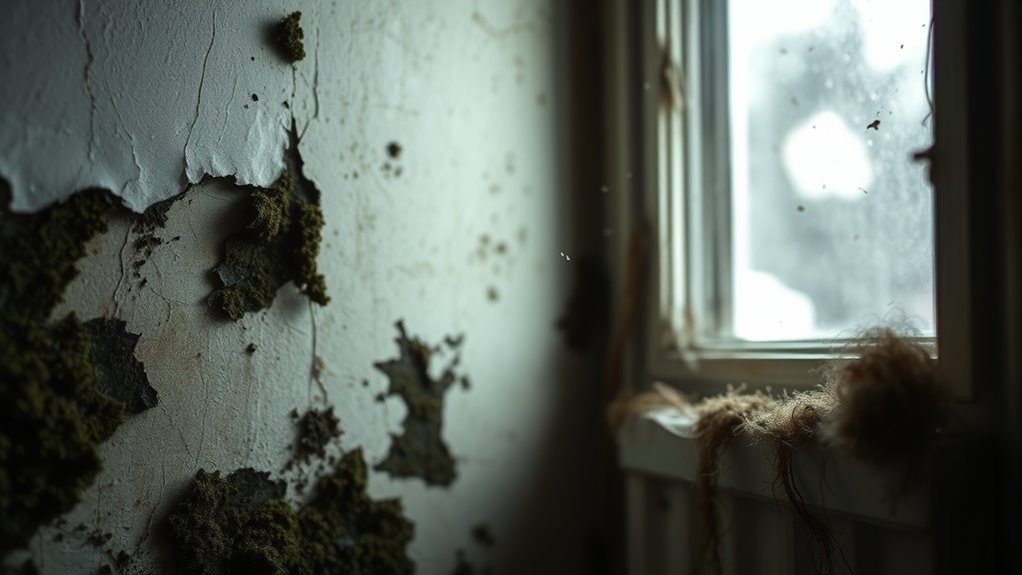
Mold is a common indoor problem that can substantially affect your air quality and your health. When mold spores become airborne, they can circulate through your home, making it harder to breathe and increasing your risk of allergic reactions or respiratory issues. Detecting mold early is essential, and this is where mold detection techniques come into play. You might notice visible signs like dark patches on walls or ceilings, but mold can also grow behind walls or under floors, where you can’t see it. Using moisture meters or hiring professionals for thorough inspections can help identify hidden mold growth. Once you’ve detected mold, addressing the source of moisture — whether it’s leaks, condensation, or high humidity — is essential to prevent it from returning. mold detection techniques are vital for ensuring a healthy indoor environment. Air filtration systems are a powerful tool in managing mold and improving indoor air quality. HEPA filters, in particular, are designed to trap tiny mold spores, preventing them from circulating in your living space. Regularly replacing filters and investing in air purifiers with HEPA technology can markedly reduce airborne spores, especially in high-humidity areas like bathrooms or basements. Proper air filtration doesn’t just help in removing mold spores; it also improves overall air quality by reducing dust, pet dander, and other allergens that can exacerbate respiratory problems. Coupled with good ventilation practices, air filtration can make your home less hospitable to mold growth and safer for your health. Preventing mold growth involves controlling indoor humidity levels, ideally keeping them below 60%. Using dehumidifiers or air conditioners can help maintain this balance, especially in damp climates or during humid seasons. Ventilating areas like bathrooms and kitchens by opening windows or installing exhaust fans reduces moisture buildup. Fixing leaks promptly and ensuring proper drainage around your home minimizes water infiltration that encourages mold growth. Additionally, routine cleaning with mold-inhibiting solutions and thoroughly drying wet surfaces prevent mold spores from settling and multiplying. Remember, mold thrives in damp environments, so the key to prevention is moisture control and consistent cleanliness. Incorporating mold detection practices and maintaining effective air filtration are essential steps to protect your indoor air quality. When you stay vigilant about moisture levels and regularly clean and inspect your home, you reduce the risk of mold-related health problems. By taking these proactive measures, you’ll create a healthier living environment that minimizes mold’s impact on your respiratory health and overall well-being.
Frequently Asked Questions
Can Mold Grow in Sealed, Airtight Homes?
Yes, mold can grow in sealed, airtight homes if there’s moisture buildup. Even with airtight ventilation, humidity from showers, cooking, or leaks can create a perfect environment for mold. To prevent this, make certain your home has mold-resistant materials and proper ventilation systems that manage moisture effectively. Regularly check for leaks or condensation, and use dehumidifiers if needed, to keep mold growth at bay in your airtight home.
How Long Does It Take Mold to Affect Health Significantly?
Think of mold growth as a stealthy shadow that gradually creeps into your health. It can start impacting you within 24 to 48 hours of exposure, especially if mold levels are high. The health impact varies, but symptoms like allergies, respiratory issues, or fatigue could appear quickly or take weeks to develop. The key is to catch mold early, so it doesn’t silently threaten your well-being.
Are All Types of Mold Equally Harmful Indoors?
Not all mold types are equally harmful indoors. Some mold spores, like Stachybotrys, produce toxins that can cause serious health issues, while others, like Penicillium, may only trigger allergies. It’s important to identify the specific mold type in your home, as certain molds pose greater risks. Regular inspection and prompt removal help prevent health problems, especially when dealing with more hazardous mold types.
Can Mold Be Completely Eradicated Once It Appears?
Many believe mold can be completely eradicated once it appears, but that’s not entirely true. Mold removal is effective, especially with professional help, but spores can linger and cause re-growth if conditions aren’t addressed. To truly prevent mold, focus on mold prevention strategies like controlling moisture and ventilation. While thorough mold removal reduces immediate risk, ongoing prevention is essential to keep mold from returning.
Does Using Air Purifiers Eliminate Indoor Mold?
Using an air purifier can help, but it doesn’t completely eliminate indoor mold. The effectiveness depends on the device’s ability to filter mold spores from the air. Look for purifiers with HEPA filters, as they excel at mold spores filtration. While they reduce airborne mold, you still need to address moisture sources and clean surfaces to prevent growth. Relying solely on air purifiers isn’t enough for all-encompassing mold control.
Conclusion
Remember, mold silently harms your health while you go about your day, often unnoticed until symptoms appear. Don’t let hidden mold threaten your comfort and well-being; instead, take proactive steps to prevent it. Because a clean, mold-free home isn’t just about appearance—it’s about safeguarding your breath, your peace, and your life. Act now, and create a safe, healthy space where you can truly breathe easy, free from the unseen dangers lurking within.
